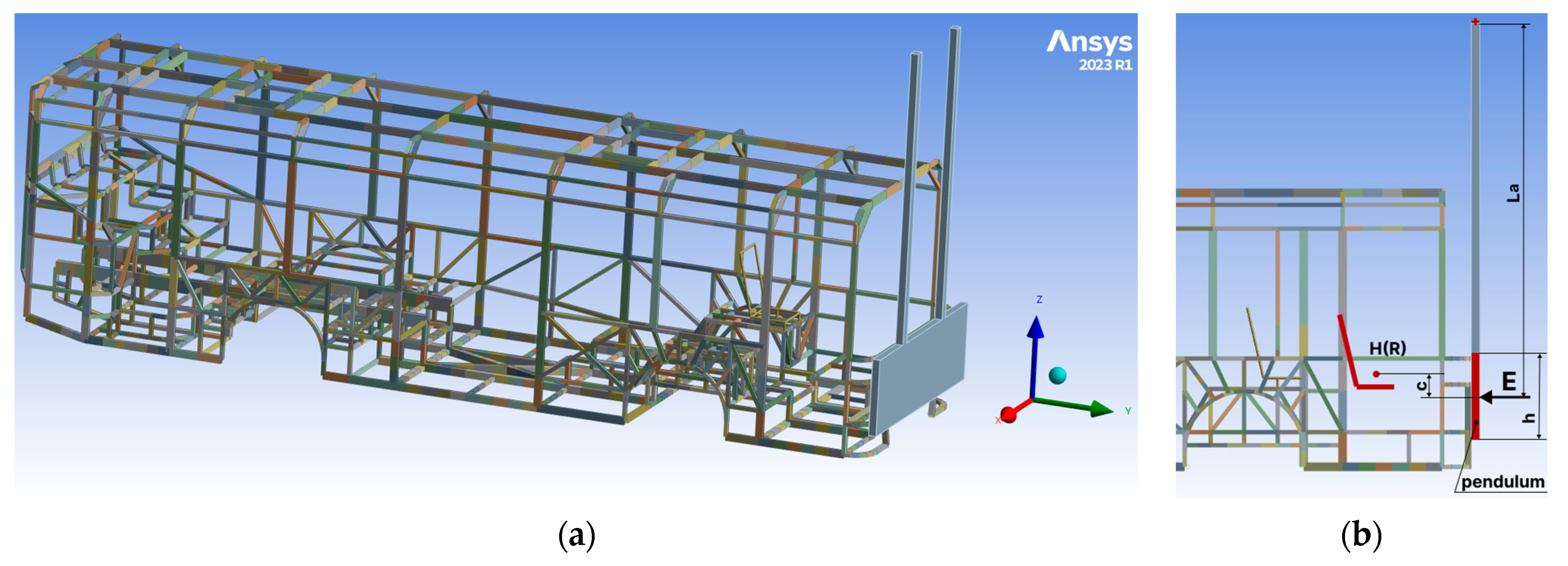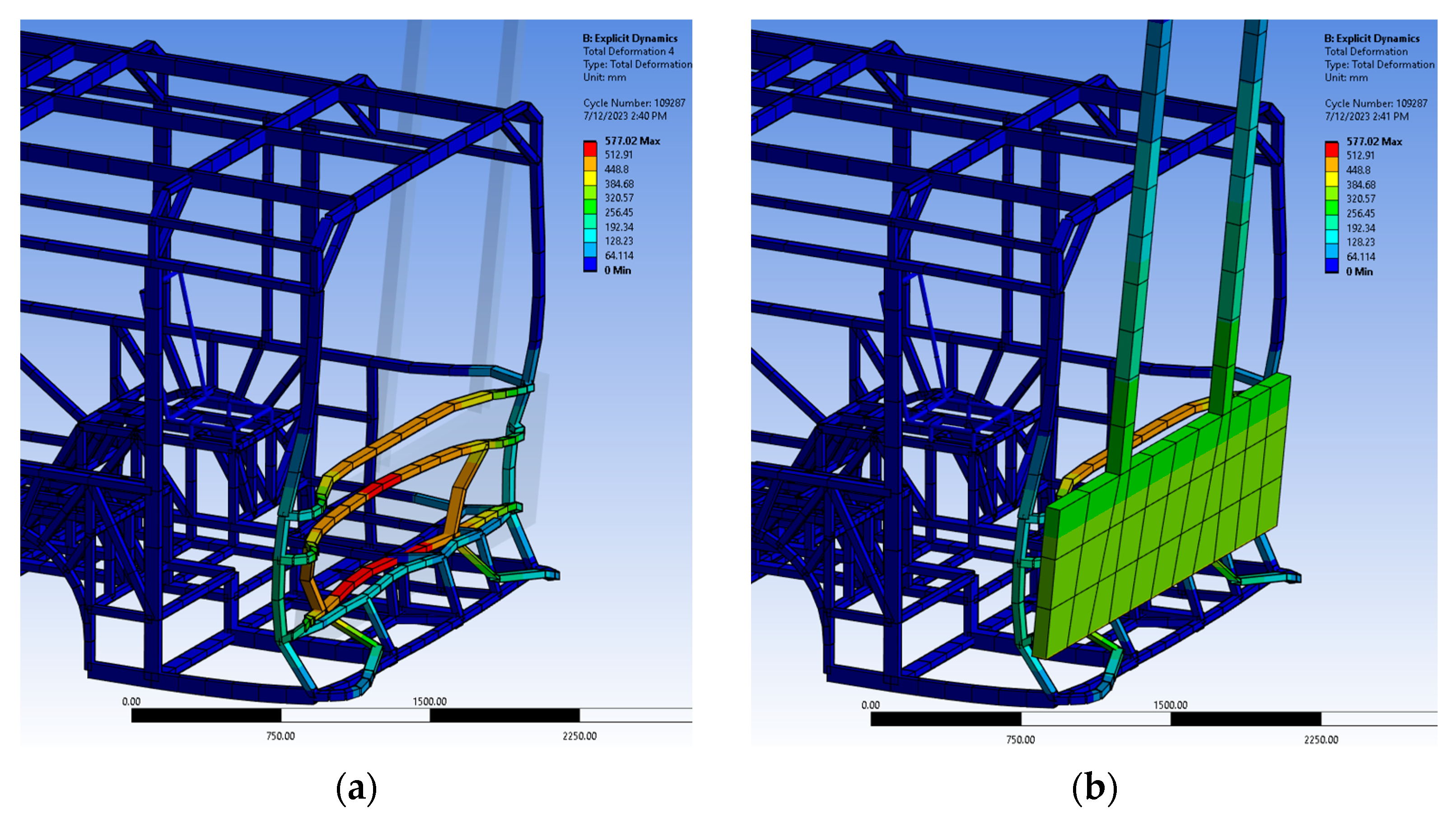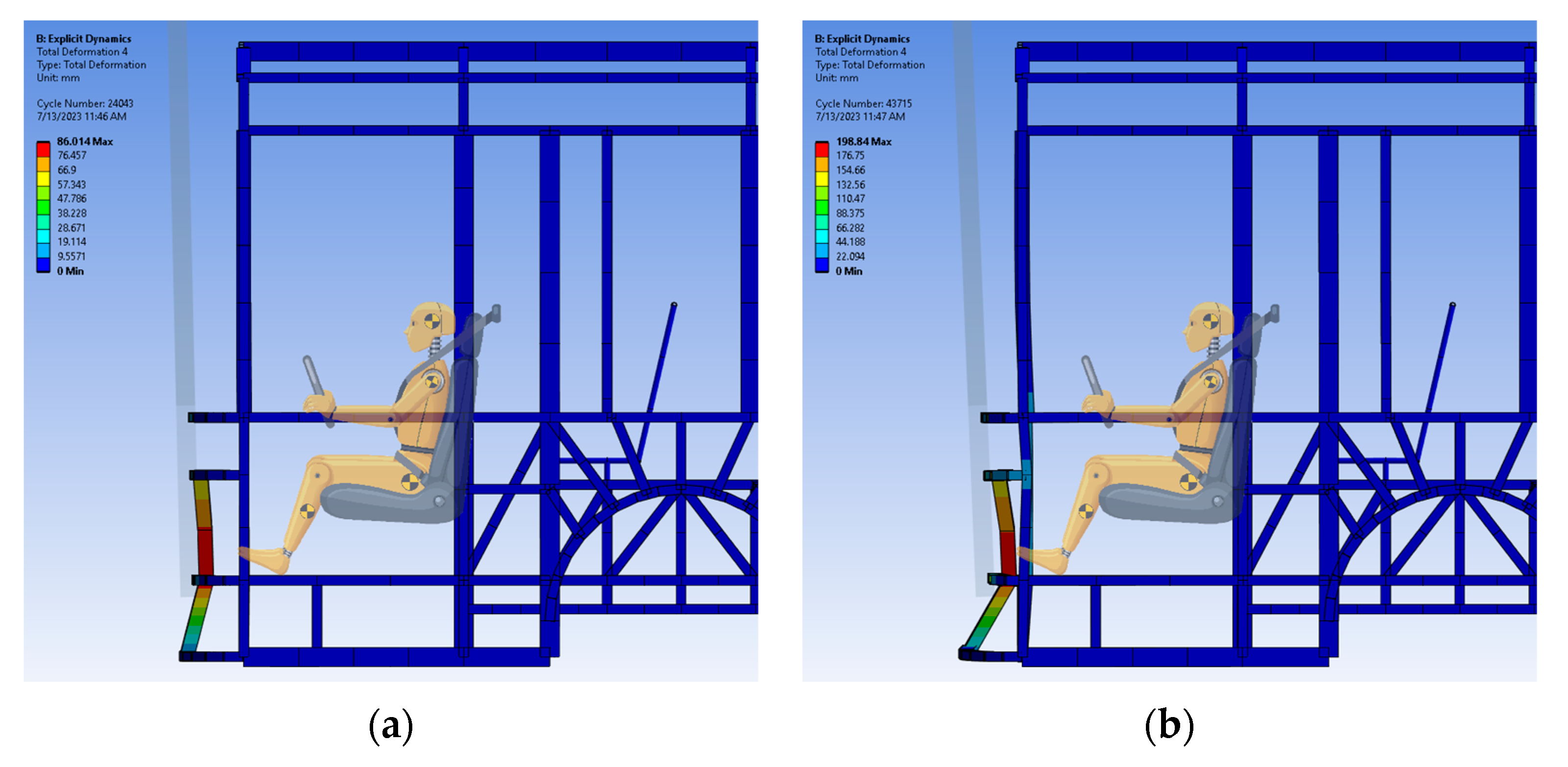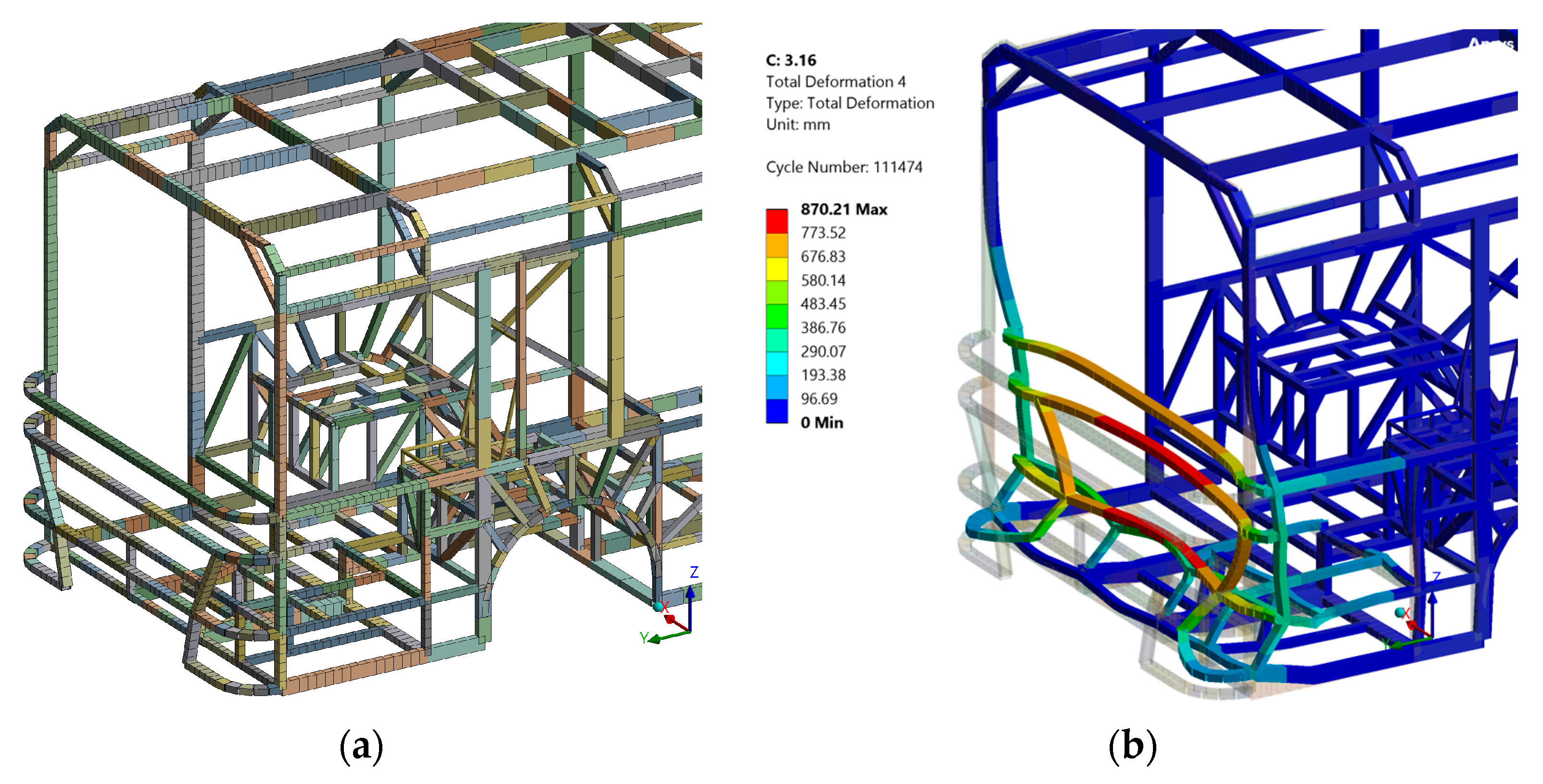Validation of Frontal Crashworthiness Simulation for Low-Entry Type Bus Body According to UNECE R29 Requirements
Abstract
:1. Introduction
- Comparing the experimental data of the MPDB test with the calculation results of the constructed analytical model, the errors of evaluation indexes (i.e., OLC, SD, and PM) are below 15%;
- The greater the stiffness of the 25% area, the less deformation of the vehicle front structure and the intrusion into the passenger compartment.
- Frontal impact with 100% overlap;
- Forty percent offset impact;
- Thirty-degree angular impact;
- And research on vehicle deformation, energy absorption characteristics of acceleration, and their changing regularity [14]. Considering that our topic is dedicated to the safety of the low-entry bus body, it is worth familiarizing yourself with a similar field of research—a paper [15] on the front impact simulation of city buses.
2. Materials and Methods
- h—the finite element characteristic length, mm.
- Materials exhibit both transverse and longitudinal waves;
- Transverse waves have a slower speed compared with longitudinal waves. As a result, the time-step size is governed by the speed of the longitudinal wave;
- The speed of a longitudinal elastic wave can be determined using Young’s modulus and density:
- E—Young’s modulus, Pa;
- —density, kg/m3.
- When Young’s modulus is larger or the density is smaller, the sound speed increases, and accordingly, a smaller time-step size should be employed.
- Young’s modulus Pa;
- Density 7850 kg/m3;
- Characteristic size of the element m;
- Required task analysis time is s.
- n—time step number required for this explicit analysis of the element with a characteristic size of .
- εp—the equivalent plastic strain, mm/mm;
- —the normalized equivalent plastic strain rate (speed of deformation),
- s−1; A, B, C—the constants of the material,
- n—the exponential of the mechanical hardening;
- m—the exponential of the thermal softening.
- 0—represents initial values (room temperature);
- —effective total strain rate (is normalized by a quasi-static threshold rate)—non-dimensional by the reference strain rate;
- —reference strain rate;
- Tm—fusion temperature, °C;
- T—current specimen temperature, °C.
- to are the constants of failure model;
- —mean stress;
- —equivalent stress.
- —represents the stress in the damaged state, while stress triaxiality and equivalent stress can be derived from the material in the undamaged state.
- Each anchor chain or rope shall be made of steel and withstand a tensile load of at least 10 tons;
- The chassis frame side members should be supported on wooden blocks over their entire width and length of not less than 150 mm (Figure 2a). The front edges of the blocks must not be forward of the rearmost point of the cab or behind the center of the wheelbase;
- The rearward movement of the chassis frame should be limited by chains or A ropes attached to the front of the chassis frame symmetrically about its longitudinal axis, with the attachment points placed at a distance of not less than 600 mm. When tensioned, the chains or ropes should form an angle of no more than 25° with the horizontal, and their projection on the horizontal plane should form an angle of no more than 10° with the longitudinal axis of the vehicle (Figure 2b).
3. Results and Discussion
- t = 35–65 ms (Figure 5a,b)—deformations are observed only in the window frame of the windshield and the structure of the front part (86 mm max). There is no risk to the driver’s legs;
- t = 100 ms (Figure 5c)—the lower part of the driver’s legs is at risk—the pedal unit is clearly deformed, which carries the risk of injury. The maximum observed model displacement is 390 mm at that moment;
- t = 137 ms (Figure 5d)—under the influence of the impactor, maximum deformations of the front part were achieved (577 mm of the lower window sill at the level of the driver’s knees). The deformation of the structure indicates a possible injury risk to the lower limbs, pelvis, and hands of the driver (the steering column will definitely enter the residential space zone).
- R29 deforms the front part well, but without affecting the rest of the bus sections (passengers do not feel the acceleration impact enough), and NCAP is more focused on assessing accelerations at control points, as in the case of R80 (passengers feel the impact enough on the seats), but the front parts are far from deformations seen with R29.
- The model case of the frontal collision simulation is to be performed both in the R29 and NCAP tests—their combination allows us to determine bus body complex safety. In addition, it is worth taking into account separate rules for the city buses, in which the maximum permissible speed should be limited to 50 km/h and the obstacle with a rigid wall with the height reduced to only 1 m.
- In fact, it is worth conducting both experiments to comprehensively evaluate the safety of the bus. This especially applies to city buses, which have an unusual speed limit of 50 km/h. One of the ideas for testing the frontal collision of city buses is to use a 1m high NCAP rigid wall (this will be consistent with the impactor parameters according to R29) and limit the speed to 50 km/h. This will definitely be a topic for future research.
4. Conclusions
- Unlike suburban and intercity buses, city buses are characterized by lower stiffness in the event of a frontal collision, which can be explained by at least two reasons:
- The load-bearing part of low-floor and low-entry buses is partially transferred from the floor to the roof, i.e., in the event of a frontal impact, the stiffness of the floor is decisive;
- The driver’s position in a city bus is lower than in an intercity bus (this is the rule, especially in the case of the R29 regulation).
- Maximum deformation values in the bus front part are reached earlier for R29 (137 ms) than for most impacts tested by NCAP (170–230 ms) but have higher values: 577 mm vs. 150–250 mm for the sills tested.
- According to the R29 results, the driver’s legs were seriously affected, judging by the deformation value for the lower window sill (maximum deformation of 577 mm) and other elements of the front part in the appropriate control points. The matrix with the results of relative deformations showed the greatest danger at the level of the driver’s knees (up to 511 mm of penetration relative to the seat mounting point A) and feet (up to 557 mm). The displacement of the pedal unit has reached almost 108 mm.
- It is unjustified to use the boundary conditions of trucks to attach the bus with chains behind its frontal axe. There are at least two reasons for this approach:
- The bus has a spatial frame for the bearing body, unlike the flat frame of the truck on the floor, so attaching chains only at specified points will not correspond to the actual impact processes of the bus itself.
- The bus has seats along its entire length, so it would be unwise to attach only the front part of the vehicle. Therefore, it is proposed to install attachment points for the pneumatic cylinders of the rear wheel suspension; such a scheme allows for plastic deformation in the area of the front of the rear wheels, which allows for absorption of impact energy.
Author Contributions
Funding
Data Availability Statement
Conflicts of Interest
References
- Tang, L.; Gan, A.; Cevallos, F.; Alluri, P. Characteristics of Bus Transit Vehicles in the United States: A 30-Year National Trend Analysis. Transp. Res. Rec. 2018, 2672, 41–51. [Google Scholar] [CrossRef]
- Hermann, T. Mass Transit Crashworthiness Statistical Data Analysis. Report No. FTA-0002. National Institute for Aviation Research. 2005. Available online: https://www.transit.dot.gov/sites/fta.dot.gov/files/docs/Crashworthiness_Report.pdf (accessed on 26 December 2005).
- Hoffenson, S.; Reed, M.; Kaewbaidhoon, Y.; Papalambros, P. On the impact of the regulatory frontal crash test speed on optimal vehicle design and road traffic injuries. Int. J. Veh. Des. 2013, 63, 39–60. [Google Scholar] [CrossRef]
- Deulgaonkar, V.; Kulkarni, M.S.; Khedkar, S.S.; Kharosekar, S.; Sadavarte, V.U. Crash Analysis of Bus Body Structure using Finite Element Analysis. Int. J. Veh. Struct. Syst. 2020, 12, 312–316. [Google Scholar] [CrossRef]
- Afripin, A.; Zainudin, A.; Sahar, M.; Yusof, M. Frontal impact on bus superstructure as per UNECE R29 and NCAP. IOP Conf. Ser. Mater. Sci. Eng. 2019, 670, 012014. [Google Scholar] [CrossRef]
- Sandner, V.; Ellway, J.; van Ratingen, M. Euro NCAP—New Frontal Impact Test with Mobile Progressive Deformable Barrier (MPDB). 2019. Available online: https://www.researchgate.net/publication/337224180_Euro_NCAP_-New_Frontal_Impact_Test_with_Mobile_Progressive_Deformable_Barrier_MPDB (accessed on 12 June 2024).
- Dima, D.; Covaciu, D. Vehicles Frontal Impact Analysis Using Computer Simulation and Crash Test. Int. J. Automot. Technol. 2019, 20, 655–661. [Google Scholar] [CrossRef]
- Seyedi, M.; Koloushani, M.; Jung, S.; Vanli, O. Safety Assessment and a Parametric Study of Forward Collision-Avoidance Assist Based on Real-World Crash Simulations. J. Adv. Transp. 2021, 2021, 1–24. [Google Scholar] [CrossRef]
- Wang, D.; Zhang, J.; Wang, S.; Hu, L. Frontal Vehicular Crash Energy Management Using Analytical Model in Multiple Conditions. Sustainability 2022, 14, 16913. [Google Scholar] [CrossRef]
- Jongpradist, P.; Saingam, N.; Tangthamsathit, P.; Chanpaibool, P.; Sirichantra, J.; Aimmanee, S. Crashworthiness analysis and design of a sandwich composite electric bus structure under full frontal impact. Heliyon 2022, 8, e11999. [Google Scholar] [CrossRef]
- Rooppakhun, S.; Bua-Ngam, S. Finite Element Analysis of High-Decker Bus Frontal Impact Based on ECE-Regulation No.29. Adv. Mater. Res. 2013, 658, 464–470. [Google Scholar] [CrossRef]
- Walber, M.; Jr, A.; Goedel, F.; Alcalá, E.; Izquierdo, F.; Iturrioz, I. Evaluation of the seat fastening in the frame of a road bus submitted to frontal impact. Lat. Am. J. Solids Struct. 2014, 11, 1463–1489. [Google Scholar] [CrossRef]
- Olivares, G.; Yadav, V. Injury Mechanisms to Mass Transit Bus Passengers During Frontal, Side and Rear Impact Crash Scenarios. NIAR, Wichita State University United States Paper Number 09-0427. 2009. Available online: https://www-esv.nhtsa.dot.gov/Proceedings/21/09-0427.pdf (accessed on 12 June 2024).
- Xiao, Y.; Zhu, W.; Zhao, H. The Safety of Body Structure and Occupant Protection Research of Medium Bus Under Three Kinds of Frontal Impact Forms. Lect. Notes Electr. Eng. 2013, 197, 279–292. [Google Scholar] [CrossRef]
- Rivera-Hernández, M.; Ramírez-Juárez, O.; Cuautle Estrada, A.; Cantor-Mexquititla, V.; Torres-SanMiguel, C. Front Impact Simulation of Urban Bus. In Engineering Design Applications IV. Advanced Structured Materials; Öchsner, A., Altenbach, H., Eds.; Springer: Cham, Switzerland, 2022; Volume 172, pp. 15–25. [Google Scholar] [CrossRef]
- Lopes, R.; Viriato, N.; Cunha, R.; Maia, R.; Rodrigues, R.; Parente, M.P.L.; Moreira, P. Coach crashworthiness and failure analysis during a frontal impact. Eng. Fail. Anal. 2023, 151, 107369. [Google Scholar] [CrossRef]
- Lopes, R.; Viriato, N.; Cunha, R.; Maia, R.; Rodrigues, R.; Parente, M.; Moreira, P. Passive Safety Solutions on Coach according ECE R29: Experimental and Numerical analyses. Procedia Struct. Integr. 2023, 42, 1159–1168. [Google Scholar] [CrossRef]
- Lashkari, A.; Aslamjaved, K.; Manjunath, V.S.; Ahuja, P. Finite Element Analysis of School Bus frame structure as per AIS029 Pendulum Impact Test using LSDYNA. Int. J. Recent Eng. Sci. 2022, 9, 1–4. [Google Scholar] [CrossRef]
- Lopes, R.; Barros, F.; Melo, F.; Viriato, N.; Moreira, P.; Cunha, R.; Maia, R.; Rodrigues, R. Simulation of a frontal impact on a coach door sub-system using a pseudo-dynamic (PSD) test. Procedia Struct. Integr. 2022, 37, 115–122. [Google Scholar] [CrossRef]
- Holenko, K.; Koda, E.; Kernytskyy, I.; Babak, O.; Horbay, O.; Popovych, V.; Chalecki, M.; Leśniewska, A.; Berezovetskyi, S.; Humeniuk, R. Evaluation of Accelerator Pedal Strength under Critical Loads Using the Finite Element Method. Appl. Sci. 2023, 13, 6684. [Google Scholar] [CrossRef]
- Murugesan, M.; Lee, S.; Kim, D.; Kang, Y.H.; Kim, N.A. Comparative Study of Ductile Damage Models Approaches for Joint Strength Prediction in Hot Shear Joining Process. Procedia Eng. 2017, 207, 1689–1694. [Google Scholar] [CrossRef]
- Bocchieri, R.T.; Kirkpatrick, S.W.; Kitzinger, D. Expansion of the Riera Approach for Predicting Aircraft Impact Damage to Steel and Concrete Buildings. In Proceedings of the 20th International Conference on Structural Mechanics in Reactor Technology (SMiRT 20), Espoo, Finland, 9–14 August 2009. [Google Scholar]
- Kernytskyy, I.; Volchenko, A.; Szlachetka, O.; Horbay, O.; Skrypnyk, V.; Zhuravlev, D.; Bolonnyi, V.; Yankiv, V.; Humenuyk, R.; Polyansky, P.; et al. Complex Heat Exchange in Friction Steam of Brakes. Energies 2022, 15, 7412. [Google Scholar] [CrossRef]
- Fornalchyk, Y.; Koda, E.; Kernytskyy, I.; Hrytsun, O.; Royko, Y.; Bura, R.; Osiński, P.; Barabash, R.; Humenuyk, R.; Polyansky, P. The impact of vehicle traffic volume on pedestrian behavior at unsignalized crosswalks. Roads Bridges—Drogi I Mosty 2023, 22, 201–219. [Google Scholar] [CrossRef]
- Kernytskyy, I.; Yakovenko, Y.; Horbay, O.; Ryviuk, M.; Humenyuk, R.; Sholudko, Y.; Voichyshyn, Y.; Mazur, Ł.; Osiński, P.; Rusakov, K.; et al. Development of Comfort and Safety Performance of Passenger Seats in Large City Buses. Energies 2021, 14, 7471. [Google Scholar] [CrossRef]
- Thamsuwan, O.; Blood, R.P.; Ching, R.P.; Boyle, L.; Johnson, P.W. Whole body vibration exposures in bus drivers: A comparison between a high-floor coach and a low-floor city bus. Int. J. Ind. Ergon. 2013, 43, 9–17. [Google Scholar] [CrossRef]
- Sudirja, S.; Hapid, A.; Amin, A.; Kaleg, S.; Budiman, A.C. Stress analysis simulations of welded and bolted joints method for full steel and composite-steel chassis structure of electric low floor medium bus. Eureka Phys. Eng. 2020, 6, 61–70. [Google Scholar] [CrossRef]
- Sahraei Esfahani, E.; Darvish, K.; Parnianpour, M.; Bateni, A. Reducing Occupant Injury in Frontal Crashes for a Low-Floor City Bus. In Proceedings of the ASME 2005 International Mechanical Engineering Congress and Exposition, Orlando, FL, USA, 5–11 November 2005; pp. 113–120. [Google Scholar] [CrossRef]








| Relative Deformation between Control and Mounting Points Along Y-Axis, mm | |||||||||
|---|---|---|---|---|---|---|---|---|---|
| Level | Hands | Knees | Feet | ||||||
| Points | 1 | 2 | 3 | 4 | 5 | 6 | 7 | 8 * | 9 |
| A | 382.9 | 154.5 | 511.4 | 412.2 | 154.5 | 557.1 | 481.1 | 107.5 | 159.8 |
| B | 346.2 | 117.8 | 474.7 | 375.5 | 117.8 | 520.4 | 444.4 | 70.8 | 123.1 |
Disclaimer/Publisher’s Note: The statements, opinions and data contained in all publications are solely those of the individual author(s) and contributor(s) and not of MDPI and/or the editor(s). MDPI and/or the editor(s) disclaim responsibility for any injury to people or property resulting from any ideas, methods, instructions or products referred to in the content. |
© 2024 by the authors. Licensee MDPI, Basel, Switzerland. This article is an open access article distributed under the terms and conditions of the Creative Commons Attribution (CC BY) license (https://creativecommons.org/licenses/by/4.0/).
Share and Cite
Holenko, K.; Dykha, O.; Koda, E.; Kernytskyy, I.; Royko, Y.; Horbay, O.; Berezovetska, O.; Rys, V.; Humenuyk, R.; Berezovetskyi, S.; et al. Validation of Frontal Crashworthiness Simulation for Low-Entry Type Bus Body According to UNECE R29 Requirements. Appl. Sci. 2024, 14, 5595. https://doi.org/10.3390/app14135595
Holenko K, Dykha O, Koda E, Kernytskyy I, Royko Y, Horbay O, Berezovetska O, Rys V, Humenuyk R, Berezovetskyi S, et al. Validation of Frontal Crashworthiness Simulation for Low-Entry Type Bus Body According to UNECE R29 Requirements. Applied Sciences. 2024; 14(13):5595. https://doi.org/10.3390/app14135595
Chicago/Turabian StyleHolenko, Kostyantyn, Oleksandr Dykha, Eugeniusz Koda, Ivan Kernytskyy, Yuriy Royko, Orest Horbay, Oksana Berezovetska, Vasyl Rys, Ruslan Humenuyk, Serhii Berezovetskyi, and et al. 2024. "Validation of Frontal Crashworthiness Simulation for Low-Entry Type Bus Body According to UNECE R29 Requirements" Applied Sciences 14, no. 13: 5595. https://doi.org/10.3390/app14135595





